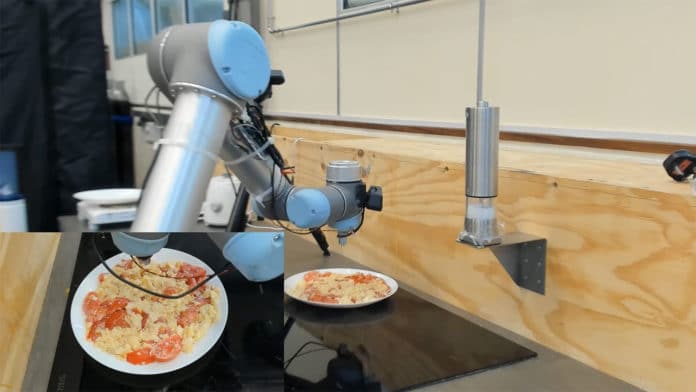Researchers from the University of Cambridge have trained a robot chef to taste the food at different stages of the chewing process to assess whether it’s sufficiently seasoned – imitating a similar process in humans. The idea is to not just have a machine that prepares pizza or burgers but to have it produce the best meal possible based on the human taster’s feedback.
The robot has already been trained to make omelets. Everyone’s tastes are different – some people love spicy food, while others have a sweet tooth. Researchers developed a new kind of machine learning algorithm that gave the robot feedback from human samplers, enabling it to improve its product over time, tweaking its methods, and whipping up an omelet that tasted great in the end.
Now, researchers have teamed up with domestic appliances manufacturer Beko to produce a new and improved version of the robot chef with its own taste-testing ability.
When we chew our food, we notice a change in texture and taste. Different ingredients of the dish undergo specific changes during chewing. For example, biting into a fresh tomato at the height of summer will release juices, and as we chew, releasing both saliva and digestive enzymes, our perception of the tomato’s flavor will change. Also, the saliva produced during chewing helps carry chemical compounds in food to taste receptors, mostly on the tongue; and the signals from taste receptors are passed to the brain, where it is determined whether something tastes good or not.
To replicate a more realistic human process of chewing and tasting in their robot chef, the researchers attached a conductance probe, which acts as a salinity sensor, to a robot arm. In tests, the robot chef tasted nine different variations of a simple dish of scrambled eggs and tomatoes, varying the number of tomatoes and the amount of salt in each dish. Using the probe, the robot tasted the dishes in a grid-like fashion, returning a reading in just a few seconds.
To imitate the change in texture caused by chewing, the team then put the egg mixture in a blender several times and had the robot test the dish again. The different readings at different points of ‘chewing’ by the robot enabled it to produce taste maps of each dish. The results showed a significant improvement in the ability of robots to assess saltiness over other electronic tasting methods, which are often time-consuming and only provide a single reading.
“When a robot is learning how to cook, like any other cook, it needs indications of how well it did,” said co-author Dr. Arsen Abdulali, also from the Department of Engineering. “We want the robots to understand the concept of taste, which will make them better cooks. In our experiment, the robot can ‘see’ the difference in the food as it’s chewed, which improves its ability to taste.”
In the future, the researchers are looking to improve the robot chef so it can taste different types of food and improve sensing capabilities so it can taste sweet or oily food.
